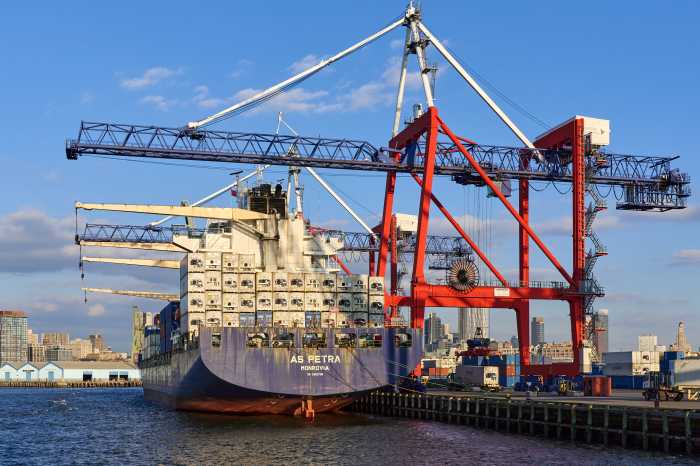
Tribeca’s N. Moore St. has not seen its historic cobblestones for many years.
BY DUSICA SUE MALESEVIC | N. Moore St. residents are upset with the state of their street, between Varick and Hudson Sts. in the historic district of Tribeca, which they say has been in disrepair for over a decade.
“This road since I’ve been here has been a disaster,” said Ron Ervolino, a resident of 26 N. Moore St., who has lived on the block since 1999.
When Ervolino first arrived on the street, it was cobblestone.
“It was very poor condition back then,” he said in a phone interview.
Even at that time, residents were making calls, he said, to get the street resurfaced but they could never get any traction. Then, suddenly and without warning, the cobblestone street was paved with asphalt in the middle of the night, said Ervolino.
“It was done very poorly and very quickly,” he recalled.
Surface work was done one more time five years ago, but Ervolino said it was not done in a satisfactory manner.
“In the duration of my time on the block, the road … has never been repaved, has never been properly surfaced,” he said. “It’s always been a Band-Aid.”
Margarit Ordukhanyan, another resident at 26 N. Moore St., moved to the block about three years ago and has not seen the street with its original cobblestone.
Ordukhanyan said that the quality of the road work was so poor that the asphalt is now broken down and that the cobblestones underneath are poking through it. Other work that was done concerning gas mains has been covered over with metal plates that bang at night when cars go over them.
There are parts of the street that are just sinking, Ordukhanyan said in a phone interview.
“There is no drainage on the street,” she said. “All these potholes and ditches collect rotting water.”
There are two restaurants on the street and when “the businesses wash down the pavement, the dirty water runs out on the street and just sits there,” she said.
Ervolino called the ponding water “unsanitary” and said that the block has had problems with rats. Both said that the smell is the worst in the winter.
Ordukhanyan said, “I have sent letters to City Hall. I have filed complaints with the Department of Transportation and Department of Sanitation.”
She said that the city did send an exterminator to take care of the rat overpopulation, but the overall condition of the street has not been addressed.
The D.O.T, she said, sent her a response that stated that the repaving of the street was not in the budget.

A D.O.T. spokesperson did not answer most questions for this article, but in an email she wrote that the agency is aware of the community’s concerns regarding the street, and is reviewing possible options.
“We have been calling and calling and calling,” said Ervolino. “For whatever reason we cannot seem to get anything to happen.”
He said that he and other residents have called 311 and have reached out to Community Board 1, councilmembers and the mayor’s office.
Ordukhanyan said that D.O.T. would send a crew to patch up a specific pothole, but that is not enough.
“It’s not going to solve the drainage problem,” she said, “It’s not going to solve the uneven street surface problem.”
Ordukhanyan will bypass her own street because she doesn’t want go down it. She says it is not safe to drive down the street and for her, there is a health and safety concern.
Another issue is the aesthetics of a street that is part of the Tribeca West Historic District. The original granite plates for the sidewalk have been maintained, but not the street.
“Somehow once you step off the sidewalk, it seems that nobody’s concerned about what that looks like,” Ordukhanyan said. “It really is not befitting historic Tribeca to have a street like this.”
Other streets in the neighborhood’s historic districts have been resurfaced.
“Every other street in our neighborhood has been re-cobbled,” she said. “It has been dolled up, properly restructured and re-cobbled to emulate historic Tribeca. The exception is this particular street block and we have no idea why.”
Ervolino said he doesn’t understand why asphalt on top of cobblestone is considered acceptable for a landmarked district.
“It’s this Frankenstein of a block, where it’s not cobblestone, it’s not really asphalt and overall it’s a complete mess,” he said.
Lynn Ellsworth, chairperson of the Tribeca Trust, said that the D.O.T. has inconsistent policies when it comes to the neighborhood’s historic districts. The same problem is happening on Duane St., where asphalt has been put on top of the cobblestone, or Belgian blocks — granite pavers the size of bricks.
“We would support N. Moore becoming cobblestone again,” Roger Byrom, chairperson of the C.B. 1’s Landmarks Committee, said in a phone interview.
The street needs to be resurfaced sooner rather than later, said Ordukhanyan.
“It has deteriorated visibly in the three and half years I’ve been living in the neighborhood,” she said. “I think the street really is in dire need of complete structural repair. And it has to be done soon because it keeps getting worse and worse.”


































